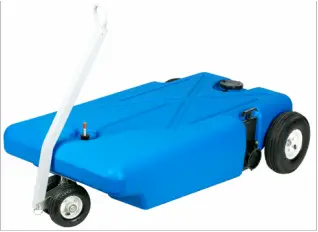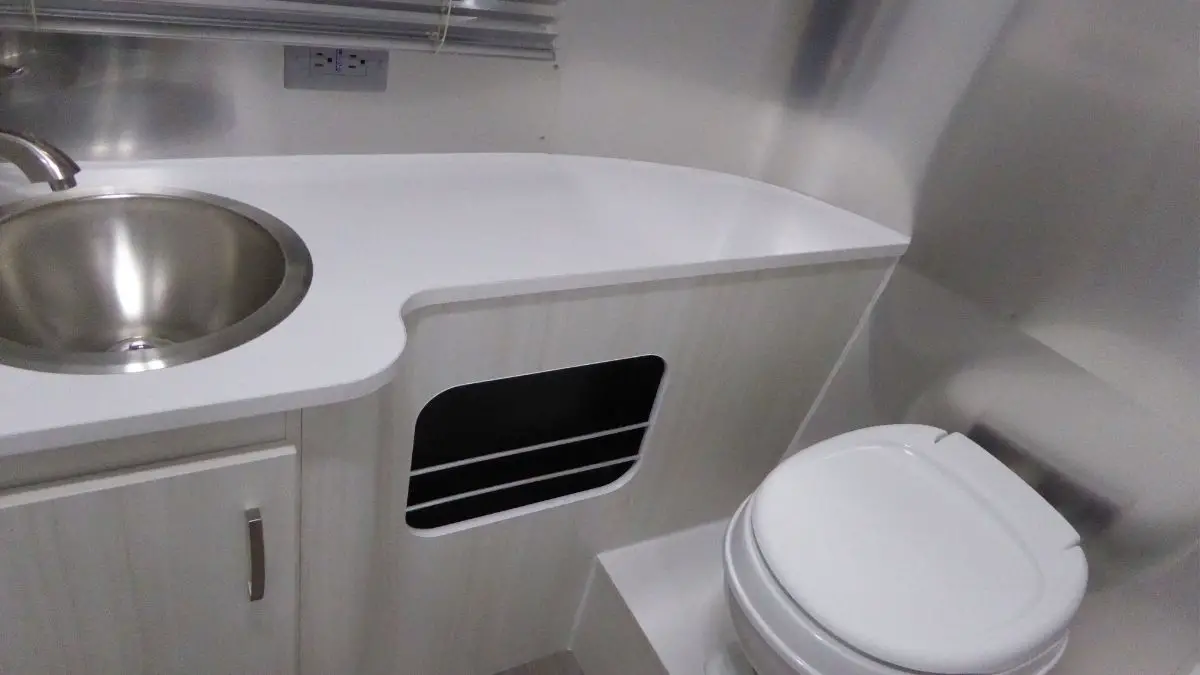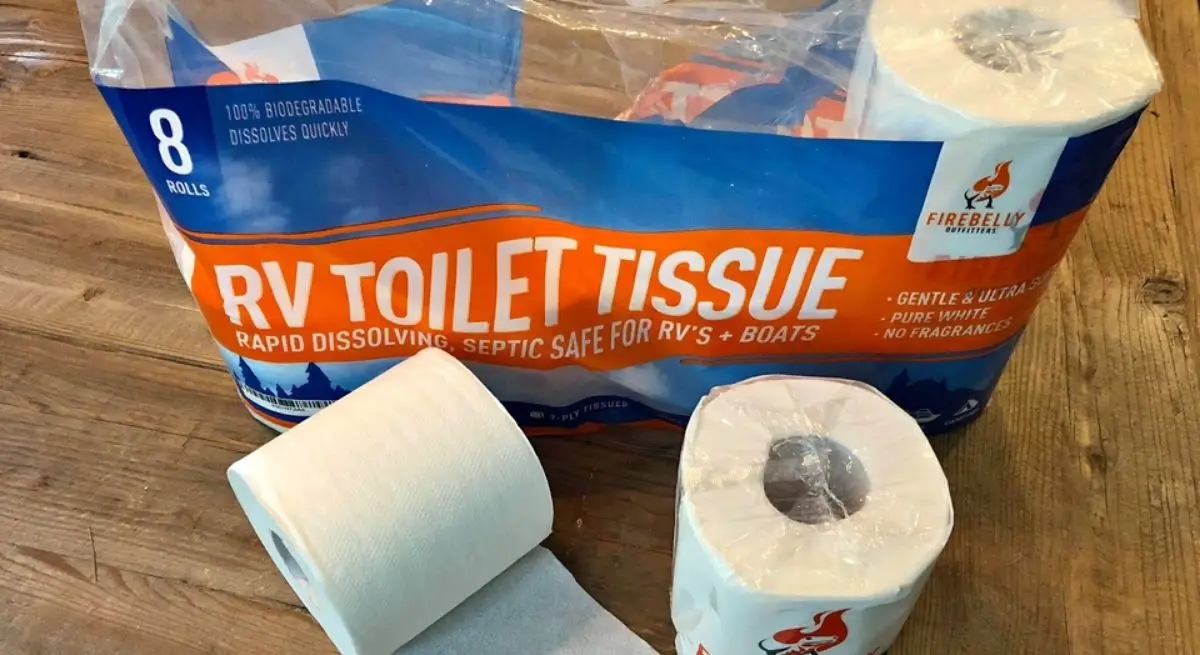To understand how RV Bathrooms work, the best place to start is to look at your own bathroom at home. Similarly, to a residential bathroom, there is fresh water that goes into the shower, the sink and toilet. Now when it comes to the wastewater, this is where an RV bathroom is a little different from your home bathroom. In your home bathroom it goes into a municipal sewer system or septic tank, in RVs the wastewater goes into two different types of storage tanks:
- A grey water tank, for dirty water that comes from your sinks in the kitchen, bathroom, and shower.
- A Black water tank that is attached to the bottom of your Toilet for solid and liquid human waste.
Once the tanks are full, one would visit a dumping station where they are emptied with a sewer pipe that attaches to the bottom of each tank of your RV and emptied into a septic system or municipal waste system. The waste holding tanks of your RV are temporary holding tanks until they can be dumped later.
Note: a common problem for RVs is that there is a sewage smell coming from the bathroom that fills the cabin of the RV. If you are having this problem, check out this article on how to fix the problem.
Common RV Bathroom Questions:
Can I Flush Toilet Paper In An RV?
One can flush toilet paper in an RV if they aren’t using too much and are using a specific toilet paper that is designed to break down quickly. An RVs plumbing system isn’t built the same as the one in a house and, as a result, can’t handle a heavy amount of toilet paper that is not designed to break down quickly.
Can you flush toilet paper in an RV? Some people choose to dispose of toilet paper instead of flushing, but this is not necessary. If one is concerned, there are a couple of manufacturers that make specific toilet paper for your RV that can be broken down easier in the dark tank. How do you know if your toilet paper is suitable for your RV? Get a couple of jars with lids and fill it with water ¾ of the way up. Now add a couple pieces of the toilet paper you want to use and place it in one jar and do the same with the other jar, but with the specific toilet paper for RVs. Now screw the lid and shake both jars up. Notice how the RV toilet paper breaks up? If your brand that you want to use also breaks up like the RV specific toilet paper, then you should be good to go.
While you do need to remember to be mindful of the amount that you use, you can flush toilet paper in an RV. Too much, and you can create a clog in the tank which will be difficult to flush out of the system when dumping the tank. Emptying your waste water tanks properly is critical for not developing future problems. Have a look at this article on how to empty your waste water tanks.
How Long Can I Shower In An RV?
The variance of time depends on the set up has such as the flow rate per minute of the shower head, the hot water tank size and if one has their system set up on sewer and have their grey water flap open.
How long can you shower in an RV? If you are staying in a campground with full hookups, have a tankless water heater, and have the cap off your grey water tank, you can shower for as long as you desire. If you don’t have access to these things, a quick 5 to 6 minute shower is advised for long time stayers or 5-10 for short weekenders.
Remember that these circumstances can change depending on the type of trip you are taking. A lengthy stay with no hookups requires more conservation of water and resources than a shorter stay in an all-inclusive campground.
How Often Does Waste Water Need To Be Dumped From Your Tanks?
Waste needs to be dumped before the tank is filled all the way to prevent any overflow from occurring. It is usually recommended to do so as soon as you notice your tank at the 2/3rds mark, but I have found that if you can get your tank as full as possible before dumping it tends to flush out the solids better, as long as you repeat the flushing out process of filling the waste water tank a few times and dumping, using the back flow nozzle on your RV, while you are at the sani dump station. Refer to this article for greater details on dumping your tank a few extra times.
How often does waste need to be dumped? This varies greatly depending on how large of a group you are travelling with, as well as how much use the bathroom is used. For 2 people, I find that the grey and dark water tanks can get filled up in as little as 2 days, but can be as long as 5 days.
If you are in a campsite that has a sewer to hook up to you won’t need to worry about this so much but if you aren’t and are planning on staying for a lengthy period, it might be a good idea to invest in a portable “honey wagon”. This is a portable device in which you can empty your black tank into until you can properly dispose of the waste.

While you don’t want to wait too long to empty your tanks when they are getting full, it’s also not a good idea to empty them too frequently. The biggest thing to remember is to always add about a gallon of water to the dark water tank to prevent a build up of toilet and waste at the bottom of the dark water tank. This build up is called stacking or pyramid waste.
How Many Gallons Of Water Does It Take To Shower In An RV?
How many gallons of water does it take to shower in an RV? This greatly depends on several factors such as the length of the shower, the type of shower head you are using and, whether you turn off the shower while lathering or not. Most showers won’t take any more than 2-6 gallons of water while many experienced campers will challenge themselves to not use any more than 1 gallon.
While most shower heads in RV’s use anywhere from 1 gpm (gallons per minute) to 2 gpm, and that is multiplied by the minutes that you would be using water. Lets take a sample shower with a 2 gpm show head.
- 1 minute to wet yourself down and get your soap wet (2 gallons)
- 2 minutes to lather up (0 gpm)
- 2 to 3 minutes to wash off the soap (4 to 6 gallons)
For a total of 4 to 8 gallons of water used for your shower.
If you aren’t hooked up to a water source, it is important to conserve as much as you can. Motorhomes can hold anywhere from 4-16 gallons of water in a tank, but the average is only 6-10 gallons. You will want to check your owner’s manual to see how much yours holds for sure, but this could mean the quickest get in and out shower that you can muster.
How Do RV Water Heaters Work?
RV water heaters operate similarly to a house water heater except smaller. Most house water heaters use one kind of fuel to heat up the water, in RVs there are either one, two or three methods to heat the hot water. The hot water in an RV is typically only turned on when you need it, so a little planning is typically required of when to turn it on.
Inside your RV is a switch for the hot water heater, that you must first turn on the hot water and select the heating method if you have more than one. If you have selected propane, then a 12 volt ignitor lights the propane that heats the hot water tank. This will take approximately an hour or so to heat the water up.
The most common method hot water heaters are heated today is with propane or electricity or both methods. You will find this is the case with all trailers, 5th wheel, truck mounts, and almost all motorhomes. A third kind of hot water heater that can be found is called Motor-aid, where the engine of the motorhome heats the water from the wasted heat of the engine in addition to having propane and electricity as heating methods. Motor-aid is not that common today.
Hot water tanks today are aluminum and typically come in 6 gallons or 10 gallons. Motor aid is the best use of wasted heat; electricity is the most efficient, when plugged into shore power. As there is no pilot to worry about going out, you just hit a button in the RV and the water will start to heat. While propane is the most common type of heating for most RV hot water tanks and instant hot water heaters and probably the most practical as it can work when dry camping or when you have hookups and is available on all RVs.
The water temperature is controlled by a thermostat that controls how long the heating method will stay on to heat the water to a temperature of 140 degrees typically. Yours might be set to a low temperature. It is possible to replace the existing thermostat with an adjustable one to lower the temperature of your hot water.
It is convenient to have hot water in your RV, but you should be aware that heating this can burn a lot of energy. When it is not needed, you should turn the heater off. If you have a steel hot water tank it can get corrosion if you run it all the time. To prevent this from happening, make sure to install an anode rod which is meant to be eaten away at instead of the tank. It is also not a bad idea to drain the tank if you are storing it for a long period.
Today, there really is only one manufacturer of hot water tanks, and that is domestic. There used to be two Atwood and domestic, but Domestic purchased Atwood.
On Demand hot water systems
Today, many new RVs leaving the manufacturing plant are now coming with on demand hot water systems. These systems are seen as more efficient and typically use propane to heat the pipes that the water travels through and gives you hot water in a shorter time than the typical hot water tanks that are in just about all RVs today. The system works by flipping a switch and a 12 volt ignites the propane that heats a smaller tank and the coils that the cold water travels through and you have hot water in seconds to a minute as opposed to waiting for 1 hr for hot water.
In Conclusion
There you have it, RV bathrooms although they look similar to your bathroom at home, are a little different and need to be treated differently. In Fact your RV Bathroom is more similar to a septic tank style of bathroom than a municipal wastewater system.




